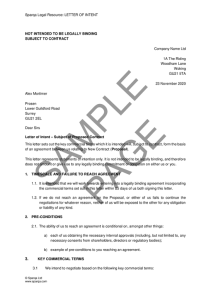 When you have started negotiations with someone outside your business (eg to collaborate on a commercial project), you should use a letter of intent to record the key terms that have been agreed and which will form the basis of your negotiations. A letter of intent is not normally legally binding, but using one can save your business time and money as it will give both parties confidence that a deal is possible. You can find out more about what a letter of intent is by reading this earlier blog in our series. Read on to find out how to create a letter of intent.
When you have started negotiations with someone outside your business (eg to collaborate on a commercial project), you should use a letter of intent to record the key terms that have been agreed and which will form the basis of your negotiations. A letter of intent is not normally legally binding, but using one can save your business time and money as it will give both parties confidence that a deal is possible. You can find out more about what a letter of intent is by reading this earlier blog in our series. Read on to find out how to create a letter of intent.
Terms to include in a letter of intent
Your letter of intent should set out the understanding of the parties as to the key terms that they will be negotiating and how they intend those negotiations to proceed. To create your own letter of intent, you can use our template, which is customisable to your negotiations and contains the key terms set out below:
1. The timescale within which you intend to reach a formal agreement
Consider including a timescale within which your negotiations will take place and after which you expect to have negotiated a full, legally binding commercial agreement. You could also include a provision that if you are unable to conclude your negotiations within that set period of time, or if either party withdraws from negotiations, neither party will have any liability to the other. Although not legally binding, this will reinforce your intent around timescales and reduce the risk of protracted negotiations.
2. Any pre-conditions to your agreement
Pre-conditions are conditions that must be met before either party can enter into a final agreement. For example, you may require certain documents to be signed or regulatory approvals to be granted. Equally, it is likely that you will be carrying out due diligence into the other party to inform you about what the key risks to the transaction might be, and a typical pre-condition might be that you receive satisfactory results to your due diligence exercise.
3. The key commercial terms
Your letter should set out the key commercial terms that the parties will be negotiating and which will need to be agreed before you enter into detailed discussions. These may include provisions about pricing, the duration of the contract, service levels, deadlines, warranties and termination events. You should also set out the key obligations of each party.
4. A declaration that the heads of terms are not intended to be legally binding
You should include a statement in your letter of intent that (if appropriate) it is not intended to be legally binding. You could also consider including the words ‘subject to contract’ at the head of the document to make it clear that (if this is the case) none of the terms in the letter have any legal status. Using this phrase will help to create a presumption against a legally binding contract having been created.
Note that in some circumstances, you may wish to include some terms in your letter of intent that are legally binding (eg a confidentiality provision or an exclusivity clause). For further guidance about the legal status of a letter of intent, read this blog.
To create your own letter of intent when you are entering into commercial discussions, use our template letter. It contains all of the key terms set out above and is customisable to your business negotiations.
Using Sparqa Legal’s letter of intent template
To use our template letter of intent, follow this link or use the button below and click ‘Get Started’. You can then complete the questionnaire to customise the letter to your commercial negotiations. Once you have finished, download and print the letter and read it through carefully before ensuring that it is signed and dated by both parties.
If you plan to disclose any business information during your negotiations, make sure you ask the other party to sign a Non-Disclosure Agreement (NDA) before doing so. See our Q&A on Protecting intellectual property and business information during meetings or negotiations for further guidance, and for templates you can use see either our mutual NDA template or our one-way NDA template.
Do both parties need to sign a letter of intent?
Although letters of intent are not generally legally binding, it is still best practice for both parties to sign the letter. This confirms that it reflects their intentions and demonstrates both their agreement in principle and their commercial commitment to negotiating a formal agreement.
The content in this article is up to date at the date of publishing. The information provided is intended only for information purposes, and is not for the purpose of providing legal advice. Sparqa Legal’s Terms of Use apply.

Before joining Sparqa Legal as a Senior Legal Editor in 2017, Frankie spent five years training and practising as a corporate disputes and investigations lawyer at leading international law firm Hogan Lovells. As legal insights lead, Frankie regularly contributes to Sparqa Legal’s blog, writing content across employment law, data protection, disputes and more.






